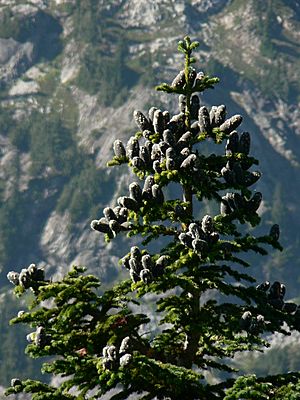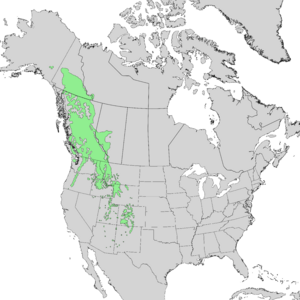Subalpine fir facts for kids
Quick facts for kids Subalpine fir |
|
|---|---|
 |
|
| Specimen in North Cascades National Park | |
| Conservation status | |
| Scientific classification | |
 |
|
| Natural range |
The subalpine fir, also called the Rocky Mountain fir, is a type of fir tree. Its scientific name is Abies lasiocarpa. This tree grows in the western parts of North America. It is known for living in high mountain areas.
Contents
What Does the Subalpine Fir Look Like?
The subalpine fir is a medium-sized evergreen conifer. This means it keeps its needles all year round. It usually grows about 20 meters (65 feet) tall. Some can even reach 40 to 50 meters (130 to 160 feet) tall! Its trunk can be up to 1 meter (3 feet) wide. The top of the tree, called the crown, is shaped like a very narrow cone.
Bark and Leaves
When the tree is young, its bark is smooth and gray. It often has small blisters filled with resin, which is a sticky sap. As the tree gets older, its bark becomes rough and cracked.
The leaves are flat and look like needles. They are about 1.5 to 3 centimeters (0.6 to 1.2 inches) long. The top side of the needles is a blue-green color. It has a wide stripe of stomata, which are tiny pores for breathing. The underside has two blue-white stripes of these pores. When a fresh leaf falls off, it leaves a reddish mark on the branch. The needles grow in a spiral pattern around the branch. However, their bases twist so they mostly point to the sides and top of the branch.
Cones and Seeds
The cones stand upright on the branches. They are about 6 to 12 centimeters (2.4 to 4.7 inches) long. When they are young, they are dark blackish-purple and have fine, soft yellow-brown hairs. As they get older, they turn brown. In early fall, the cones break apart to release their winged seeds. These wings help the seeds fly away in the wind.
Types of Subalpine Fir
Scientists sometimes group subalpine firs in different ways. There are usually two or three main types:
- The Coast Range subalpine fir is the most common type. It grows in the Pacific Coast Ranges, like the Olympic Mountains and the Cascade Range. You can find it from southeast Alaska down to California.
- The Rocky Mountains subalpine fir is very similar. It grows in the Rocky Mountains, from eastern Alaska down to Colorado. This type has slightly different resin and its fresh leaf scars are yellow-brown, not reddish.
- The corkbark fir is found in Arizona and New Mexico. It has thicker, corky bark and its needles look more blue-white.
Where Does the Subalpine Fir Grow?
The subalpine fir is native to many mountain areas. In Western Canada, it grows in Yukon, British Columbia, and western Alberta. In the Western United States, it is found in southeastern Alaska, Washington, Oregon, Idaho, western Montana, Wyoming, Utah, Colorado, New Mexico, Arizona, northeastern Nevada, and northwestern California.
High Altitude Homes
This tree prefers to grow at high altitudes. In the northern parts of its range, it can be found from 300 to 900 meters (1,000 to 3,000 feet) high. Sometimes, in the far north, it can even grow near sea level. In the southern parts of its range, it grows much higher, from 2,400 to 3,650 meters (7,900 to 12,000 feet). It is often found right at or just below the tree line, which is the highest point where trees can grow.
How Animals Use the Subalpine Fir
Many animals use the subalpine fir. Game animals like deer or elk eat its bark. Grouse, which are a type of bird, eat its leaves. Songbirds, Richardson's grouse, and squirrels also eat the seeds from its cones. Other small mammals also enjoy the seeds.
How People Use the Subalpine Fir
The wood from subalpine fir trees is used for many things. It is used for building materials and to make paper. It is also a popular choice for a Christmas tree during the holidays.
Ornamental Tree
The subalpine fir is also a popular ornamental tree. People plant it in parks and large gardens because of its beautiful blue-green needles. There is a special type called Abies lasiocarpa var. arizonica 'Compacta'. This type is smaller and grows like a shrub, making it good for smaller gardens. It can grow up to 4 meters (13 feet) tall and 1.5 meters (5 feet) wide. This variety has even won an award for its beauty in gardens.
Traditional Uses
Some Plateau Indian tribes used the subalpine fir in traditional ways. They would make a special tea or wash in water where parts of the tree had been boiled. They did this for purification or to help their hair grow.
Images for kids
-
Specimen in Olympic National Park in mid-September
-
Specimen in Mount Rainier National Park in late September
See also
 In Spanish: Abeto alpino para niños
In Spanish: Abeto alpino para niños




